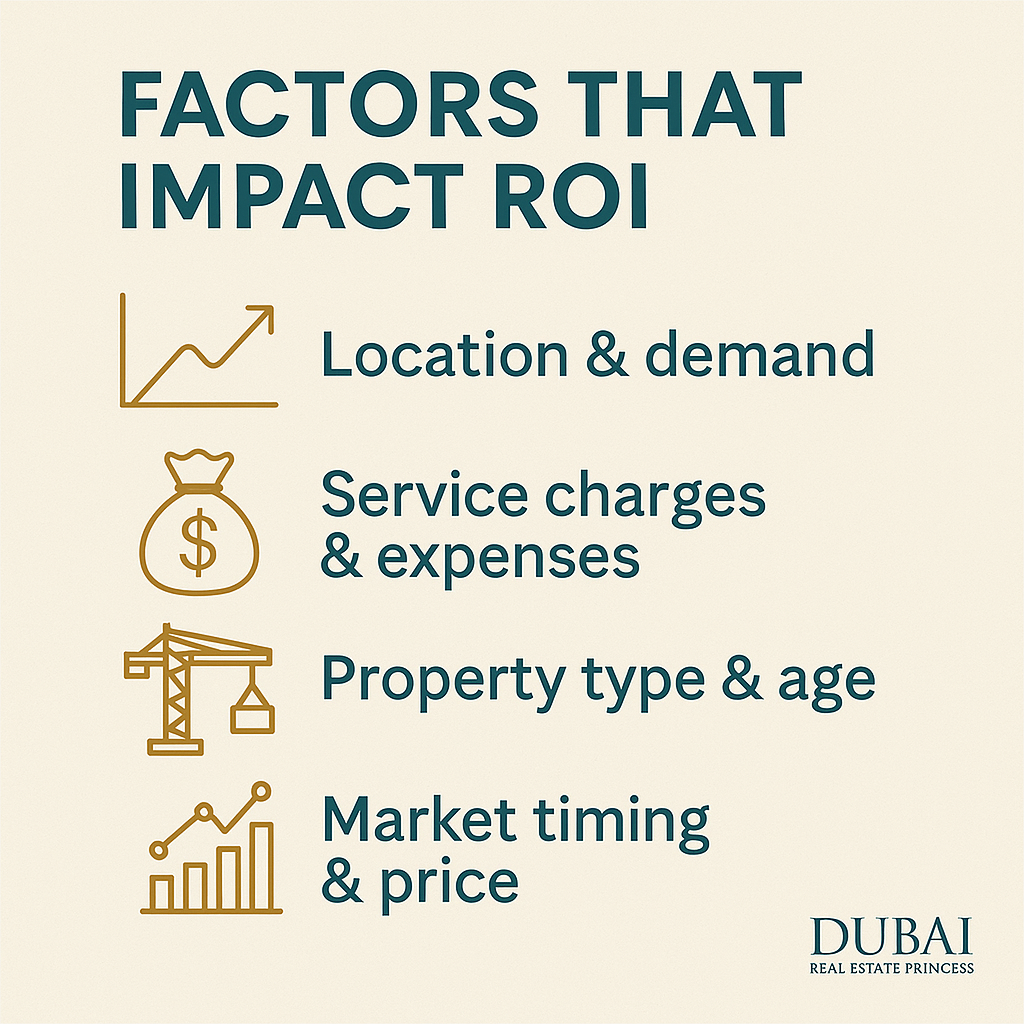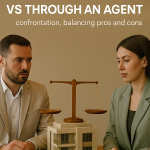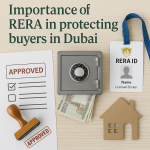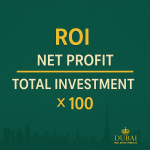Dubai’s real estate market is undergoing rapid growth, attracting investors from across the globe
One key reason is the strong returns properties can generate from high rental yields to capital appreciation all in a tax-free environment.
Before diving into this dynamic market, it’s vital to understand how to calculate the Return on Investment (ROI) for a property. Calculating ROI before buying helps you determine if a Dubai property will be profitable, allowing you to compare opportunities and make an informed choice.

This guide will walk you through what ROI means in real estate, how to calculate it (with examples), and what a “good” ROI looks like in Dubai’s top areas.
Understanding ROI in Real Estate
Return on Investment (ROI) is a simple metric that measures how profitable an investment is relative to its cost. In real estate, ROI tells you what percentage of your money you’re getting back as profit. The formula is straightforward:
ROI = (Net Profit / Total Investment Cost) × 100%
“Net profit” means the money you earn from the investment (through rental income or resale gain) after subtracting all costs, and “Total Investment Cost” includes the purchase price and any other expenses to acquire and maintain the property . The result is expressed as a percentage, showing how much return you make for every dirham invested.
For example, if you buy a property for AED 1,000,000 and later sell it for AED 1,200,000 after one year, let’s say your net profit (after paying agent fees, etc.) is AED 150,000. Using the formula, your ROI would be:
• ROI = (AED 150,000 / AED 1,000,000) × 100 = 15% 
This 15% represents the return on your initial investment in one year. ROI isn’t limited to resale profits it also applies to rental income.
Suppose you invest AED 1,000,000 in a Dubai property and rent it out. If the annual rent is AED 80,000 and you have AED 20,000 in expenses (maintenance, service charges, etc.), your net annual rental income is AED 60,000.
The annual ROI from rental would be:
• ROI = (AED 60,000 / AED 1,000,000) × 100 = 6% 
In essence, ROI combines rental yield and any capital gains to show your total return. Many investors focus on rental yield (annual rental income divided by property price) as an indicator of ROI, since it’s a reliable yearly measure.
In Dubai, rental yields are quite attractive often higher than in many global cities which significantly boosts ROI for buy-to-let properties .
What Is a “Good” ROI in Dubai?
ROI expectations can vary, but Dubai’s real estate generally offers robust returns. In the residential market, an ROI of 7%–10% is considered healthy .
In fact, a desirable ROI in Dubai can range roughly 6% to 12%, depending on property type and location .
• Apartments vs. Villas: Property type plays a role. Apartments in Dubai tend to have higher rental yields – averaging around 7.3% annual ROI – whereas villas often average closer to 5%  . Apartments generate more rental income relative to their price, while villas might appreciate more over the long term.
• Popular Areas: Location is another big factor. Prime communities like Downtown Dubai or Dubai Marina are highly desirable and see consistent demand, often yielding ROI on the higher end of the spectrum (around 5%–7% annually in rental returns) .
More affordable areas like Jumeirah Village Circle (JVC) or International City can offer even higher rental ROI (commonly 6%–9%), thanks to lower purchase prices and solid rental demand  . On the other hand, ultra-luxury areas such as Palm Jumeirah have slightly lower rental ROI (around 4%–6%), since property prices are very high relative to rents though these areas may promise strong long-term capital appreciation.
Keep in mind that what constitutes a “good” ROI also depends on your investment strategy and comparisons to other investment options. In any case, doing the math upfront is essential. Below, we’ll go step-by-step through calculating ROI on a Dubai property before you buy, so you can confidently evaluate any opportunity.
How to Calculate ROI: Step-by-Step Guide
Calculating ROI for a Dubai property involves a few simple steps. Essentially, you need to figure out how much you’re investing in total, how much income the property will generate (net of expenses), and then apply the ROI formula. Let’s break it down:
1. Calculate Your Total Investment: Add up all costs involved in acquiring the property, not just the purchase price. This includes the property price plus expenses like Dubai Land Department (DLD) transfer fees, agent commission, legal fees, and any initial repairs or renovations. In Dubai, the property transfer fee is about 4% of the purchase price and agency commission is around 2% on resale properties . These can add roughly 6% on top of the price, which significantly impacts your total investment. For example, if you buy a property for AED 1,500,000, you should factor in about AED 90,000 (6%) in purchase-related fees . If you’re taking a mortgage, include any loan fees and the down payment in your calculation of how much cash you’re investing. Don’t forget smaller costs like valuation fees or Oqood (for off-plan properties).
2. Estimate Your Annual Rental Income: If you plan to rent out the property, determine how much rent it can earn in a year. Research similar properties in the area to find the monthly rental rate. Then multiply by 12 to get the annual rental income . For instance, if a 2-bedroom apartment in Dubai Marina rents for around AED 10,000 per month, the yearly rental income would be AED 120,000 . (If you plan to flip the property instead of renting, you would estimate the future resale price and the likely profit, but this can be speculative. Rental income provides a more immediate and quantifiable ROI.)
3. Subtract Annual Expenses: To get your net income, you must account for all costs of owning and operating the property each year  . Typical annual expenses include:
• Service charges (building maintenance fees paid to the developer or homeowners association, common for apartments and communities).
• Maintenance and repairs (upkeep of the property, fixing wear-and-tear issues).
• Property management fees (if you hire a management company, usually ~5–10% of rent).
• Insurance (home insurance or landlord insurance, if applicable).
• Utilities and other bills (if the owner covers any, or during vacant periods).
• Allowance for vacancy – it’s wise to assume the property might be empty for a certain period (e.g. a few weeks per year) between tenants, which effectively reduces annual income .
Subtract all these annual costs from the annual rental income to get the Net Annual Income. For example, if the property brings in AED 120,000 in rent and you expect about AED 20,000 in total yearly expenses (maintenance, service charge, etc.), the net income would be AED 100,000 per year  .
4. Apply the ROI Formula: Now calculate the ROI percentage. Take the Net Annual Income (from step 3) and divide it by the Total Investment (from step 1), then multiply by 100. Using the numbers above: if your net yearly income is AED 100,000 and your total investment (purchase price + all fees) was AED 1,590,000, then:
• ROI = (100,000 / 1,590,000) × 100 = ~6.3%.
Here’s another example for clarity: suppose your total investment was AED 1,500,000 and net income is AED 100,000, then ROI = (100,000 / 1,500,000) × 100 = 6.67% . This means you’re earning about a 6.7% return on your investment annually.
The table below illustrates an ROI calculation example for a Dubai property:
Item | Amount (AED) | Explanation |
Property Purchase Price | 1,500,000 | Initial price of the property |
Purchase Fees (Approx. 6%) | 90,000 | e.g. 4% DLD fee + 2% agent commission |
*Total Investment Cost* | 1,590,000 | Sum of price and one-time costs |
Annual Rental Income | 120,000 | Expected yearly rent (e.g. 10k/month) |
Annual Expenses | 20,000 | Maintenance, service charge, etc. |
Net Annual Income | 100,000 | Rent minus expenses (120k – 20k) |
ROI | ≈ 6.3% | (Net Income / Total Investment) × 100 |
Note: If you plan to use financing (a mortgage), you might also calculate cash-on-cash ROI, which considers your cash invested (down payment and costs) vs. the net income after mortgage payments. For simplicity, the ROI examples above consider total property value as the investment.
If you only put 20% down on that AED 1.5M property (i.e. AED 300k) and have a mortgage, your cash ROI would be much higher but remember to subtract interest payments from net income in that case.
Leverage can boost ROI, but also carries risk , so factor in mortgage costs carefully.
Factors Affecting ROI in Dubai
Not all properties will have the same ROI. Here are some key factors that influence your returns in Dubai’s real estate market:
• Location: Location is king in real estate ROI. Properties in prime, high-demand areas tend to command higher rents and see stronger appreciation. For example, Downtown Dubai, Dubai Marina, and Palm Jumeirah are prestigious areas popular with both residents and tourists, leading to steady rental demand and potential price growth .
These areas can deliver excellent ROI potential over time. However, they also come with higher purchase prices. In contrast, emerging or more budget-friendly areas like Jumeirah Village Circle (JVC), Dubai Sports City, or International City have lower entry prices and often provide higher rental yield percentages, which boosts ROI  . When evaluating ROI, compare the rental yields of different communities. A community with high demand but relatively low prices will usually offer the best percentage returns.
• Property Type: ROI can vary by property type. Generally, apartments yield higher rental returns percentage-wise than villas or townhouses  . A studio or one-bedroom apartment in a busy area might generate an 7–8% annual yield, whereas a luxury villa might only yield 4–5% annually in rent (but could appreciate more in value). Consider your investment goals: if you want strong rental income cash flow, apartments or smaller units might be ideal . For long-term growth, a villa in a prime area might pay off when you sell, even if yearly rent ROI is lower.
• Purchase Price and Market Timing: The price you pay for the property directly affects ROI. Negotiating a good purchase price or buying during a market dip can significantly improve your returns. Dubai’s property market can cycle, so savvy investors watch for optimal entry points. Likewise, buying off-plan (directly from a developer before a project is completed) often comes at a lower price with payment plans, which can lead to a higher ROI if the property value rises by handover .
• Rental Demand & Occupancy: High occupancy is crucial for a good ROI. Dubai’s rental market is generally strong – the city’s status as a global business hub and tourist destination means a steady influx of expats and visitors needing housing . However, ROI will suffer if your property sits empty. Investing in areas with consistent rental demand (near business districts, tourist attractions, or public transport) can minimize vacancy periods. Properties that appeal to the largest renter pool (e.g. mid-range apartments in popular neighborhoods) tend to maintain high occupancy.
• Expenses and Maintenance: Ongoing costs directly reduce your net income, so they affect ROI . Dubai apartments come with annual service charges (which can be anywhere from ~AED 10 to 30+ per square foot depending on the building amenities). Maintenance costs vary based on the property’s age and quality newer properties may need less maintenance, while older ones could have higher upkeep bills.
If you opt for professional property management or frequently have to cover minor repairs, these will eat into your returns. Always budget for these costs when calculating ROI. For example, if two properties have the same rent, but one has double the service charges of the other, the one with lower expenses will yield a better ROI.
• Market Conditions: Broader market factors can impact ROI as well. Dubai’s real estate market is influenced by supply and demand, economic growth, interest rates, and government regulations. Changes such as new visa rules for investors or major infrastructure projects can boost demand and rents.
Conversely, an oversupply of new units in one area might pressure rents down. Keeping an eye on market trends will help you adjust your expectations and strategy.
Fortunately, Dubai’s economy has been resilient and the government often introduces initiatives (like long-term visas, Expo-driven projects, etc.) that stimulate real estate investment.
• Tax Environment: One big advantage for ROI in Dubai is the tax-free environment. The UAE levies no property tax, no capital gains tax, and no income tax on rental income for individuals. This means your gross rental yield is not eroded by taxes, unlike in many other countries.
For example, an 8% rental yield in Dubai is truly 8% to you, whereas an 8% yield in another market might effectively become 5% after taxes. This boosts the net ROI for Dubai properties and is a compelling reason international investors flock to this market.
By considering all these factors, you can better assess what ROI a given property is likely to deliver and whether it meets your investment goals.
Calculating ROI before buying a Dubai property will give you a clear picture of the investment’s potential profitability. A solid ROI (often in the high single digits for Dubai residential properties) indicates that the property can generate healthy returns, whether through rental income, capital appreciation, or both. Remember to include all costs in your calculations and be realistic about rents and expenses a common mistake is to overlook fees or assume 100% occupancy with no maintenance, which skews the ROI upward unrealistically.
Dubai remains a top choice for real estate investors worldwide, thanks to its combination of high rental yields, zero taxes on real estate income, and a thriving economic environment  . By taking the time to calculate ROI and research the market, you’ll be well-positioned to maximize your returns in this dynamic city. Whether you’re looking at a glitzy apartment in Downtown or a cozy unit in an up-and-coming community, always run the numbers first. If the projected ROI meets your target (for example, hitting that ~8% sweet spot), you can invest with confidence. If not, it might be wise to explore other options or negotiate a better deal.
Need guidance on the Dubai property market? We’ve helped many international buyers and investors through free consultations to find high-ROI opportunities and navigate the buying process. If you want expert advice tailored to your goals, feel free to reach out for a complimentary consultation. Contact us via WhatsApp at +971585259680 or email at info@dubairealestateprincess.com – our team of professionals is ready to assist you in making a sound, profitable investment in Dubai real estate. Happy investing!
Related posts:
Explore the hidden psychology behind why investors and high-net-worth individuals are irresistibly drawn to Dubai’s luxury real estate — from emotional triggers and prestige signals to financial confidence and future vision.
Thinking of investing in Dubai? Here’s an honest, data-driven look at buying directly from the developer vs working with an agent including ROI, legal safety, and negotiation advantages.
Categories
- 🏡 Nad Al Sheba Living
- Business Bay / Downtown Dubai
- ⛳ Jumeirah Golf Estates Living
- 💧 District One Living
- 🌳 Dubai Hills Living
- 🌊 Palm Jumeirah Living
- Testimonials & Success Stories
- Community Events & Sustainability
- Eco-Luxury Lifestyle Blog
- Luxury Rental Market
- Dubai’s Green Communities
- Property Management & Sustainability
- Relocation to Dubai
- Off-Plan Developments
- Investment Opportunities
- 🌿 Al Barari Living
- Buyer Resources
- Dubai Real Estate Princess
- Off-Market Exclusives
- Eco-Luxury Properties
- Sustainable Investing
- Luxury Living in Dubai
- Sellers’ Guide
- Dubai Market Insights
- House architecture
- News


 🏙️ The Psychology of Buying Luxury Property in Dubai
🏙️ The Psychology of Buying Luxury Property in Dubai
 Buying Directly From Developer vs Through an Agent: What Dubai Buyers Need to Know
Buying Directly From Developer vs Through an Agent: What Dubai Buyers Need to Know
 Importance of RERA in Protecting Buyers in Dubai
Importance of RERA in Protecting Buyers in Dubai
 Off-Plan vs Ready Properties — Which Gives Better Returns in Dubai 2025?
Off-Plan vs Ready Properties — Which Gives Better Returns in Dubai 2025?
 How to Calculate ROI Before Buying a Dubai Property
How to Calculate ROI Before Buying a Dubai Property